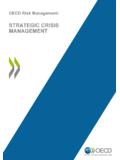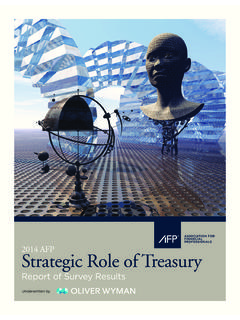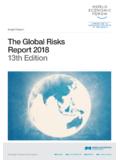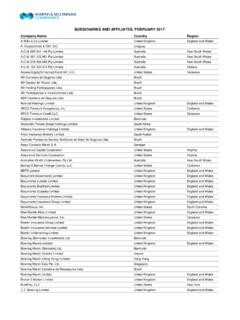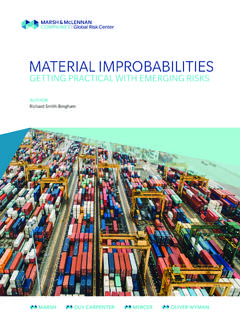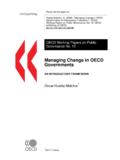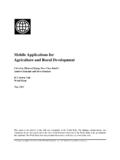Transcription of STRATEGIC CRISIS MANAGEMENT - Marsh & …
1 OECD Risk MANAGEMENT : STRATEGIC CRISIS MANAGEMENT OECD Risk MANAGEMENT : STRATEGIC CRISIS MANAGEMENT Charles Baubion 3 STRATEGIC CRISIS MANAGEMENT OECD 2013 TABLE OF CONTENTS Note by the OECD Secretariat .. 4 1. Introduction .. 5 2. New forms of crises are calling for new and innovative CRISIS MANAGEMENT responses .. 6 New nature of CRISIS .. 6 Increased vulnerabilities of modern societies .. 7 Changing roles of governments and increased demand from citizens and the media .. 7 A changing landscape for risk managers .. 8 3. Managing crises remains at the core of government s roles in risk MANAGEMENT .
2 8 4. CRISIS MANAGEMENT : traditional approach vs. dealing with novelty .. 9 CRISIS MANAGEMENT frameworks and concepts .. 9 CRISIS Preparedness: planning scenarios vs. preparing for the unknown .. 10 Risk assessment: sectoral analysis based on historical events vs. national risk assessment .. 10 Emergency planning: scenario-based vs. capability-based and network building .. 13 Training: testing plans and procedures vs. STRATEGIC exercises and networks building .. 15 Activation: Early Warning Systems triggering emergency plans vs. STRATEGIC foresight .. 16 Response: Command and Control vs.
3 Adaptative capacities .. 18 Operational picture: CRISIS development monitoring vs. sense-making .. 18 Response: Standard Operating Procedures vs. managing large response network .. 19 Leadership: CRISIS communication vs. meaning-making .. 20 End of CRISIS : improving CRISIS response vs. rebuilding trust .. 21 5. Identifying key cross-cutting issues in inter-agency CRISIS MANAGEMENT .. 22 BIBLIOGRAPHY .. 25 Boxes Box 1. The System for the Analysis and Visualisation of Risk Scenarios in Mexico .. 11 Box 2. The Netherlands National Risk Assessment .. 12 Box 3. Plan SISMO in Mexico, a good example of scenario-based emergency planning.
4 13 Box 4. Sharing common values all along a diversified response network .. 14 Box 5. STRATEGIC CRISIS MANAGEMENT Exercises: examples from Germany and Switzerland .. 16 Box 6. Integrated Early Warning System in Korea .. 16 Box 7. Measuring geopolitical tensions based on market forces .. 17 Box 8. United States Incident Command System .. 18 Box 9. UK Science Advisory Group in Emergencies (SAGE) .. 19 Box 10. Italy Civil Protection Operational Committee at national level with all stakeholders .. 20 Box 11. International co-operation frameworks supporting CRISIS MANAGEMENT .. 24 4 STRATEGIC CRISIS MANAGEMENT OECD 2013 Note by the OECD Secretariat This work was conducted as part of the OECD High-Level Risk Forum, established in 2011 to offer a venue to achieve a shared and defined vision of integrated risk MANAGEMENT , of which inter-agency CRISIS MANAGEMENT is a core component.
5 This report draws on the discussions held at the occasion of the workshop on Inter-Agency CRISIS MANAGEMENT organised jointly organised by the OECD and the Swiss Federal Chancellery in Geneva, Switzerland on 28 June 2012. The workshop gathered 40 participants from 12 OECD countries, academia, the private sector and international organisations to discuss the challenges that they are confronted with in crises MANAGEMENT . The agenda, summary and key presentations at the workshop can be found there: The goal of this report is to: highlight the changing landscape of CRISIS , discuss and assess practices of CRISIS MANAGEMENT , contribute to identifying good practice.
6 This report identifies five topics as key cross-cutting public governance issues that CRISIS MANAGEMENT policies and practices should pay attention to: an overall CRISIS governance framework, the role of science and expertise, leadership issues, the governance of networks, and international cooperation. International exchange of experiences among governments and the development of common approaches is the aim of the High Level Risk Forum of the OECD. As developing principles on risk MANAGEMENT is one of the Forum s objectives, these five areas could feed into the development of principles on CRISIS MANAGEMENT .
7 The establishment of a network of CRISIS managers under the auspices of the OECD High-Level Risk Forum will further develop these exchanges of good practices. Developing a knowledge hub on CRISIS MANAGEMENT and expanding its reflections to international co-operation to support CRISIS MANAGEMENT are options for further work of this network. This report, written by Charles Baubion, benefited from comments and feedback from Jack Radisch and was prepared under the supervision of St phane Jacobzone from the Public Governance and Territorial Development Directorate of the OECD.
8 Production assistance was provided by Lia 1 The OECD Secretariat is grateful for the support received from the Swiss Federal Chancellery to hold a joint workshop with OECD on interagency CRISIS MANAGEMENT , and wishes to thank Dr. Nicolas Mueller and Dr. Christoph Doktor from its Federal CRISIS MANAGEMENT & STRATEGIC Leadership Training Center. This research was also made possible thanks to the financial support of the governments of France, Korea, Norway, Sweden and the United States, as well as AXA, EADS, Oliver Wyman and Swiss Re to the OECD High Level Risk Forum ( ).
9 5 STRATEGIC CRISIS MANAGEMENT OECD 2013 1. Introduction Governments are confronted with an increasing number of crises, often consisting of new threats. They may spread beyond national borders and may create significant economic knock-on effects. The OECD report on Future Global Shocks (OECD, 2011) highlights the vulnerabilities of our interconnected, global economy. In the wake of the financial and fiscal crises, global leaders are acutely aware that further systemic shocks could severely challenge economic recovery, social cohesion and even political stability. Governments are always at the forefront of efforts to manage these disruptive events, and citizens' trust in government is directly affected by how swiftly and efficiently governments react in CRISIS situation.
10 The complexities of modern crises often require the involvement of many actors, above and beyond emergency services, and this demands effective co-ordination for a successful outcome. The need for co-ordination also raises significant public governance challenges, as CRISIS MANAGEMENT functions are often exercised at sub-national levels, but co-ordinated at the centres of governments. The capacity to co-ordinate CRISIS MANAGEMENT is a fundamental element of good governance, as it tests governments' capacity to provide the appropriate responses at the right time, in order to protect their citizens and businesses and mitigate the impact of disasters.
